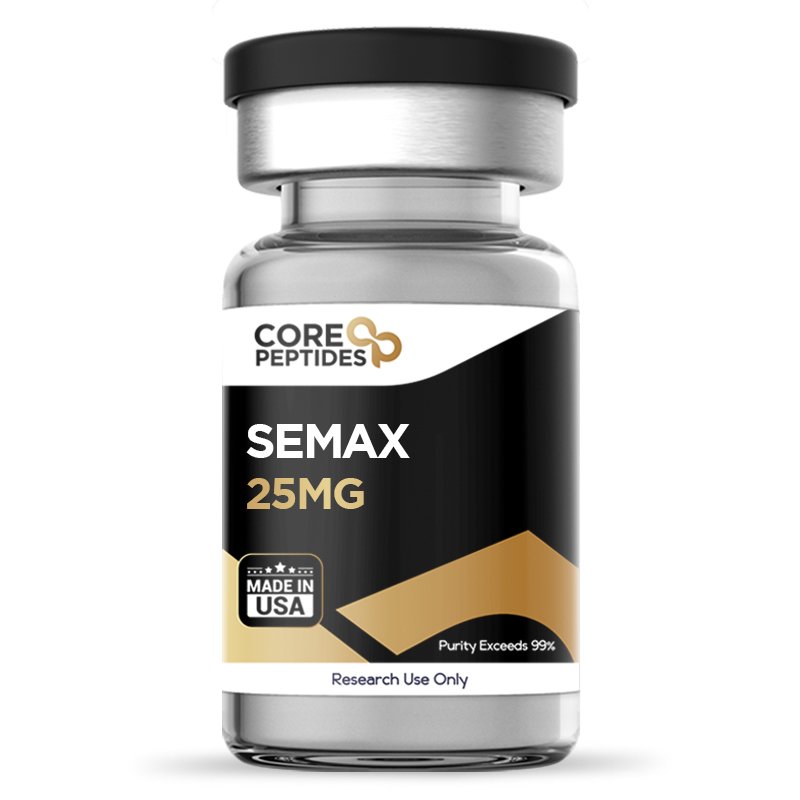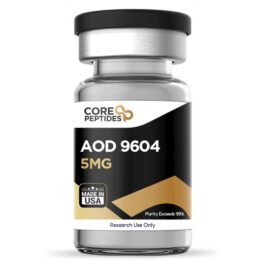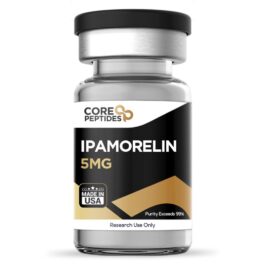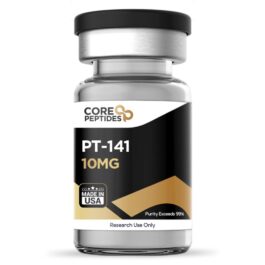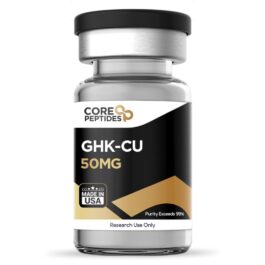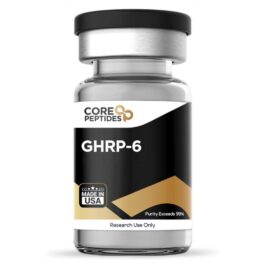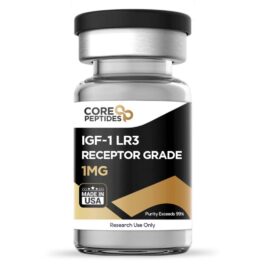Semax (25mg)
$63.00
Size: 25mg
Contents: Semax (25mg)
Form: Lyophilized powder
Purity: >99%
SKU: P-SEMAX-25
FREE Shipping on $200+ orders
Discount per Quantity
| Quantity | Discount | Price |
|---|---|---|
| 5 - 8 | 5% | $59.85 |
| 9 + | 10% | $56.70 |
Semax Peptide
Semax peptide is a synthetic polypeptide analog of an adrenocorticotropic hormone fragment 4-7 (ACTH 4-7),(1) a hormone secreted by the anterior pituitary gland. This fragment has been reported by researchers not to exhibit any action characteristic of ACTH itself but may have a potentially specific action within the brain.(2)
Researchers find that naturally occurring peptides may occasionally exhibit instability and easy degradation by biological enzymes, such as those found in gastrointestinal and cerebrospinal fluids. Consequently, researchers aim to synthesize analogs of these naturally occurring but potentially unstable peptides to induce similar biological action with the added value of higher stability. Semax is one such synthetically developed derivative of an endogenous adrenocorticotropic hormone fragment. The Met-Glu-His-Phe sequence in Semax is extended by adding a Pro-Gly-Pro (PGP) sequence at its C-terminal end. This modification with PGP may potentially enhance the molecule's ability to cross the blood-brain barrier (BBB) by increasing its lipophilicity. This increase in lipophilicity may facilitate the molecule’s passive diffusion or uptake through mechanisms such as lipid raft-mediated endocytosis, which may circumvent the tight junctions that typically restrict entry into the brain. Furthermore, the presence of PGP at the peptide's C-terminus might also modify its interactions with specific transporters or receptors on the BBB, potentially favoring its transport via receptor-mediated transcytosis. Moreover, the acetylation of Semax may improve its stability by making it more resistant to enzymatic breakdown, thereby extending its half-life in biological settings.
Overview
Synthetically developed Semax has been widely researched for its potential mechanism of action and lauded for its apparent biological stability. Researchers suggest it may inhibit select enzymes that regulate the degradation of enkephalins, naturally released neurotransmitters secreted in the brain, which scientists consider may regulate several biological functions. Enkephalins are believed to be significantly involved in nociception (the sensory perception of pain) and stress response. Moreover, an elevation in enkephalin concentrations might potentially impact other neurotransmitter systems due to the intricate interconnections between the opioid system and neurotransmitters such as dopamine and serotonin. This interaction may manifest through modulation or alteration of neurotransmitter release, receptor activity, or signal transduction pathways, indicating a sophisticated and multifaceted relationship that remains an area of active research. In addition to enkephalins, Semax has been evaluated for its potential to inhibit other peptide-degrading secreted enzymes.
Based on one specific research study,(4) Semax may induce elevated secretion and release of dopamine as well as possibly increasing the levels of brain-derived neurotrophic factor (BDNF). Based on another study,(5) Semax has been speculated to also host the potential to alter gene expressions that modulate the immune system. In altering gene expression, the levels of immune cells and their mobility may be elevated. Semax was reported by researchers to exhibit altering potential in the encoding of chemokines and immunoglobulins, related to the functioning of the vascular system.
Chemical Makeup
Molecular Formula: C39H54N10O10S
Molecular Weight: 854.99 g/mol
Other Known Titles: ACTH (4-7)PGP, HY-P1146
Research Studies and Clinical Trials
Semax Peptide and Nootropic Action
An initial study(6) was conducted on ACTH hormone and its analogs, including Semax, to determine its nootropic potential in murine models. After peptide exposure in the models, 5-hydroxyindoleacetic acid (5-HIAA) levels were monitored. 5-HIAA levels appeared elevated by 25% after 2 hours of Semax presence. The levels appeared to increase gradually up to a maximum of 180% within 4 hours of peptide exposure. It was noted by researchers that the peptide, when introduced 20 minutes before D-amphetamine, appeared to lead to an elevation of 5-HIAA as compared to exposure to Semax alone. 5-HIAA is a primary metabolite of serotonin, which indicates that Semax might enhance serotonergic activity. This hypothetical influence on serotonin metabolism might enhance the functions of serotonin-dependent pathways, which may affect operations within the central nervous system. This speculative action underscores a possible modulation of neurotransmitter systems that play critical roles in mood, cognition, and overall brain function.
Semax Peptide and Neonatal Anxiety Models
The main aim of this study(7) was to expose neonatal murine models to an SSRI and then Semax, to evaluate the interaction. Murine models aged between 1 and 14 days received an SSRI, followed by Semax on days 15 to 28. After 28 days, it was noted that upon exposure to the SSRI, the rats exhibited anxiety-like behavior, with an apparently impaired response to stressors and new stimuli during the first 14 days. Following Semax exposure, these SSRI-induced actions appeared to be mitigated, with the rats even exhibiting improved learning abilities and an overall reduction in anxiety-driven behaviors. Researchers posited that Semax might have reestablished normal levels of monoamines in the brain, which may have been initially decreased by the SSRI. By affecting these neurotransmitter systems, Semax might restore or stabilize neural pathways that were previously disrupted. Such changes might balance the excitatory and inhibitory signals in the brain, creating a state more conducive to reduced anxiety. For instance, by potentially increasing serotonin levels, Semax may improve mood and decrease anxiety, while optimizing dopamine might enhance motivation and reward processing. Furthermore, norepinephrine adjustments might improve attention and vigilance. Behavioral assessments conducted in the experiment indicated that these potential actions of Semax appeared temporally stable. The reduction in anxiety-related behaviors was sustained from adolescence through young adulthood, suggesting that Semax might have a lasting influence on neural circuits. This enduring stability implies that Semax might support creating a protective or corrective action on these circuits that persists beyond immediate exposure.
Semax Peptide and the Vascular System
In this study,(8) researchers evaluated the potential of Semax to protect murine heart models from vascular damage after experimental myocardial infarction (MI). The murine models were induced with myocardial infarction, and a cohort of the models were exposed to Semax in an experimental group for the following 6 days. On the 28th day, it was reported by the researchers that the murine models that served as a control group appeared to have developed cardiac hypertrophy along with decreased arterial blood pressure. The Semax-exposed models exhibited signs indicating preventing diastolic pressure growth in the left ventricle, with apparent left ventricle remodeling. Notably, the peptide may have ameliorated both cardiomyocyte hypertrophy and the imbalance between the growth of contractile and mitochondrial apparatus.
Semax Peptide and Neonatal Deprivation
Adolescent rats(9) were separated from their mothers for approximately 5 hours per day during postnatal days 1 to 14. From days 15 to 28, these adolescent rats were then exposed to the Semax peptide. After 28 days, it was found that during maternal deprivation, when Semax was not present, there was an apparent increase in anxiety and physical and emotional reactivity in the rats. Upon Semax exposure, researchers reported that reactions and anxiety in the rats appeared restored to control levels.
Semax Peptide and Neuroprotection
This clinical trial(10) was conducted on 100 models of ischemic stroke. A cohort representing 30% of the models was exposed to Semax, whereas the rest were evaluated as a control group. Following the study, researchers reported that following Semax exposure, there appeared to be an improvement in the rate of restoration of damaged neurological functions. All results were analyzed using EEG mapping.
Semax Peptide and Nootropic Properties
A small-scale clinical trial(11) was conducted in which research models were given Semax under high-stress conditions, and subsequent brain activity was monitored. At the end of the study, after a total of 24 hours, researchers reported that compared to normal pre-trial thresholds, the models appeared to exhibit increased memory recall and increased focus intervals.
Semax peptide is available for research and laboratory purposes only. Please review and adhere to our Terms and Conditions before ordering.
References:
- T. Kolomin et al., A New Generation of Drugs: Synthetic Peptides based on Natural Regulatory peptides. Neuroscience & Medicine, 2013, 223-252. Published Online December 2013. http://dx.doi.org/10.4236/nm.2013.44035
- Dornbush RL, Nikolovski O. ACTH 4-10 and short-term memory. Pharmacol Biochem Behav. 1976;5(Suppl 1):69-72. doi: 10.1016/0091-3057(76)90331-2. PMID: 189333. https://pubmed.ncbi.nlm.nih.gov/189333/
- Kost NV, Sokolov OIu, Gabaeva MV, Grivennikov IA, Andreeva LA, Miasoedov NF, Zozulia AA. Ingibiruiushchee deĭstvie semaksa i selanka na énkefalindegradiruiushchie fermenty syvorotki krovi cheloveka [Semax and selank inhibit the enkephalin-degrading enzymes from human serum]]. Bioorg Khim. 2001 May-Jun;27(3):180-3. Russian. doi: 10.1023/a:1011373002885. PMID: 11443939. https://pubmed.ncbi.nlm.nih.gov/11443939/
- Shih-Jen Tsai, Semax, an analogue of adrenocorticotropin (4–10), is a potential agent for the treatment of attention-deficit hyperactivity disorder and Rett syndrome, Medical Hypotheses, Volume 68, Issue 5, 2007, Pages 1144-1146. https://doi.org/10.1016/j.mehy.2006.07.017
- Medvedeva, E.V., Dmitrieva, V.G., Povarova, O.V. et al. The peptide semax affects the expression of genes related to the immune and vascular systems in rat brain focal ischemia: genome-wide transcriptional analysis. BMC Genomics 15, 228 (2014). https://doi.org/10.1186/1471-2164-15-228
- Eremin KO, Kudrin VS, Saransaari P, Oja SS, Grivennikov IA, Myasoedov NF, Rayevsky KS. Semax, an ACTH(4-10) analogue with nootropic properties, activates dopaminergic and serotoninergic brain systems in rodents. Neurochem Res. 2005 Dec;30(12):1493-500. doi: 10.1007/s11064-005-8826-8. PMID: 16362768.
- Nataliya Yu. Glazova, Daria M. Manchenko, Maria A. Volodina, Svetlana A. Merchieva, Ludmila A. Andreeva, Vladimir S. Kudrin, Nikolai F. Myasoedov, Natalia G. Levitskaya, Semax, synthetic ACTH(4–10) analogue, attenuates behavioural and neurochemical alterations following early-life fluvoxamine exposure in white rats, Neuropeptides, Volume 86, 2021, 102114, ISSN 0143-4179. https://doi.org/10.1016/j.npep.2020.102114
- Gavrilova SA, Golubeva AV, Lipina TV, Fominykh ES, Shornikova MV, Postnikov AB, Andrejeva LA, Chentsov IuS, Koshelev VB. [Protective effect of peptide semax (ACTH(4-7)Pro-Gly-Pro) on the rat heart rate after myocardial infarction]. Ross Fiziol Zh Im I M Sechenova. 2006 Nov;92(11):1305-21. Russian. PMID: 17385423. https://pubmed.ncbi.nlm.nih.gov/17385423/
- Volodina MA, Sebentsova EA, Glazova NY, Levitskaya NG, Andreeva LA, Manchenko DM, Kamensky AA, Myasoedov NF. Semax attenuates the influence of neonatal maternal deprivation on the behavior of adolescent white rats. Bull Exp Biol Med. 2012 Mar;152(5):560-3. English, Russian. doi: 10.1007/s10517-012-1574-2. PMID: 22803132. https://pubmed.ncbi.nlm.nih.gov/22803132/
- Gusev EI, Skvortsova VI, Miasoedov NF, Nezavibat'ko VN, Zhuravleva EIu, Vanichkin AV. Effektivnost' semaksa v ostrom periode polusharnogo ishemicheskogo insul'ta (klinicheskoe i élektrofiziologicheskoe issledovanie) [Effectiveness of semax in acute period of hemispheric ischemic stroke (a clinical and electrophysiological study)]. Zh Nevrol Psikhiatr Im S S Korsakova. 1997;97(6):26-34. Russian. PMID: 11517472. https://pubmed.ncbi.nlm.nih.gov/11517472/
- Asmarin IP, Nezavibat'ko VN, Miasoedov NF, Kamenskiĭ AA, Grivennikov IA, Ponomareva-Stepnaia MA, Andreeva LA, Kaplan AIa, Koshelev VB, Riasina TV. Nootropnyĭ analog adrenokortikotropina 4-10-semaks (15-letniĭ opyt razrabotki i izucheniia) [A nootropic adrenocorticotropin analog 4-10-semax (l5 years experience in its design and study)]. Zh Vyssh Nerv Deiat Im I P Pavlova. 1997 Mar-Apr;47(2):420-30. Russian. PMID: 9173745. https://pubmed.ncbi.nlm.nih.gov/9173745/
